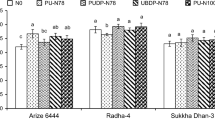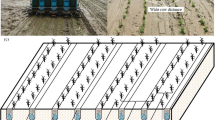Abstract
Dry-seeded rice is often fertilized by broadcasting prilled urea on the soil surface shortly before permanent flood commences. Although this method is more efficient than nitrogen application at other stages, nitrogen loss is still substantial (up to 40%). Therefore we compared the efficiency of broadcast urea prills with various forms of urea banded below the soil surface shortly before permanent flood.
Banding urea prills increased plant recovery of applied15N from 37% (broadcast) to 46% (banded), while recovery with point-placed urea supergranules was even higher (49%). Plant recovery from banded urea treated with DCD (dicyandiamide) or PPD (phenylphosphorodiamidate) was not higher than from banded urea prills. Loss of applied15N averaged 25%, with no significant differences between treatments. The increased plant nitrogen recovery with banding was associated with reduced immobilization of15N in the soil, rather than reduced losses. The increase in plant nitrogen recovery was relatively small compared with total nitrogen uptake by the plants, and consequently there was no significant improvement in yield or agronomic efficiency.
There are practical difficulties associated with banding before permanent flood. When the soil is too wet, unacceptable amounts of soil disturbance and plant damage occur. On the other hand, when the soil is dry and cracked, the depth of banding is no greater than the depth to which broadcast urea prills are transported by the irrigation water at the commencement of permanent flood.
Similar content being viewed by others
References
Bacon PE (1985) The effect of nitrogen application time on Calrose rice growth and yield in south-eastern Australia. Aust J Exp Agric 25: 183–190
Bacon PE and Heenan DP (1987) Nitrogen budgets for intensive rice growing in Southern Australia. In: Freney JR, Wetselaar R, Trevitt ACF and Simpson JR (eds) Efficiency of Nitrogen Fertilizers for Rice, pp 89–95. Los Baños: International Rice Research Institute
Boerema EB (1967) Placement of nitrogen fertilizer for rice in Southern Australia. Int Rice Comm Newsl 16: 17–24
Boerema EB (1974) Growth and yield of rice in the Murrumbidgee Valley as influenced by climate, method of sowing, plant density and nitrogen nutrition. M Sc. thesis, Macquarie University, New South Wales
Brandon DM, Wilson FE Jr and Leonards WJ Jr (1981) The effect of nitrification inhibitors and sulphur-coated urea on nitrogen fertilizer efficiency in drill-seeded Labelle rice. Annu Prog Rep, State Univ Agric Exp Stn Louisiana pp 88–95
Brandon DM, Laing TR, Leonards WJ Jr, Rawls SM and Simoneaux NJ (1982) Timing of basal N fertilizer in relation to permanently flooding drill-seeded rice in northeast Louisiana. Annu Prog Rep, State Univ Agric Exp Stn Louisiana pp 108–113
Brandon DM, Laing TR, Leonards WJ Jr, Rawls SM and Simoneaux NJ (1983) Timing of basal N fertilizer in relation to permanently flooding drill-seeded rice in northeast Louisiana. Annu Prog Rep, State Univ Agric Exp Stn Louisiana pp 109–115
Cao ZH, De Datta SK and Fillery IRP (1984) Effect of placement methods on floodwater properties and recovery of applied nitrogen (15N-labeled urea) in wetland rice. Soil Sci Soc Am J 48: 196–203
Humphreys E, Muirhead WA, Melhuish FM and White RJG (1987a) Effects of time of urea application on combine-sown Calrose rice in south-east Australia. I. Crop response and N uptake. Aust J Agric Res 38: 101–112
Humphreys E, Muirhead WA, Melhuish FM, White RJG, Chalk PM and Douglas LA (1987b) Effects of time of urea application on combine-sown Calrose rice in south-east Australia. II. Mineral nitrogen transformations in the soil-water system. Aust J Agric Res 38: 113–127
Humphreys E, Chalk PM, Muirhead WA, Melhuish FM and White RJG (1987c) Effects of time of urea application on combine-sown Calrose rice in south-east Australia. III. Fertilizer nitrogen recovery, efficiency of fertilization and soil nitrogen supply. Aust J Agric Res 38: 129–138
Humphreys E, Freney JR, Muirhead WA, Denmead OT, Simpson JR, Leuning R, Trevitt ACF, Obcemea WN, Wetselaar R and Cai Gui-xin (1988) Loss of ammonia after application of urea at different times to dry-seeded, irrigated rice. Fert Res 16: 47–57
Humphreys E, Melhuish, FM, Muirhead WA, White RJG, Blackwell J and Chalk PM (1989) The growth and nitrogen economy of rice under sprinkler and flood irrigation in south-east Australia. III.15N balance. Irrig Sci 10: 281–292
IRRI (1982) IRRI Annual Report for 1981. Los Baños: International Rice Research Institute
Katyal JC, Singh B, Vlek PLG and Craswell ET (1985) Fate and efficiency of nitrogen fertilizers applied to wetland rice. II. Punjab, India. Fert Res 6: 279–290
Mamaril CP, Diamond RB, Villapando RR and Cacnio VN (1987) Fertilizer evaluation for rice: 1984 INSFFER trials. In: Freney JR, Wetselaar R, Trevitt ACF and Simpson JR (eds) Efficiency of Nitrogen Fertilizer for Rice, pp. 205–222. Los Baños: International Rice Research Institute
Norman RJ, Wells BR and Moldenhauer KAK (1989) Effect of application method and dicyandiamide on urea-nitrogen-15 recovery in rice. Soil Sci Soc Am J 53: 1269–1274
Patrick WH Jr and Peterson FJ (1967) Higher rice yields by preventing nitrogen loss. La Agric 10: 4–5
Patrick WH Jr and Reddy KR (1976) Fate of fertilizer nitrogen in a flooded rice soil. Soil Sci Soc Am J 40: 678–681
Patrick, WH Jr, Peterson FJ and Turner FT (1968) Nitrification inhibitors for lowland rice. Soil Sci 105: 103–105
Prasad R and De Datta SK (1979) Increasing fertilizer nitrogen efficiency in wetland rice. In: Nitrogen and Rice, pp. 465–483. Los Baños: International Rice Research Institute
Reddy KR and Patrick WH Jr (1980) Uptake of fertilizer nitrogen and soil nitrogen by rice using15N-labelled nitrogen fertilizer. Plant Soil 57: 375–381
Reddy KR, Patrick WH Jr and Phillips RE (1980) Evaluation of selected processes controlling nitrogen loss in flooded soils. Soil Sci Soc Am J 44: 1241–1246
Savant NK, Craswell ET and Diamond RB (1983) Use of urea supergranules for wetland rice: a review. Fert News 28: 27–35
Schnier HF, De Datta SK, Mengel K, Marqueses EP and Faronilo JE (1988) Nitrogen use efficiency, floodwater properties, and nitrogen-15 balance in transplanted rice as affected by liquid urea band placement. Fert Res 16: 241–255
Simpson JR, Freney JR, Wetselaar R, Muirhead WA, Leuning R and Denmead OT (1984) Transformations and losses of urea nitrogen after application to flooded rice. Aust J Agric Res 35: 189–200
Simpson JR, Freney JR, Muirhead WA and Leuning R (1985) Effects of phenylphosphorodiamidate and dicyandiamide on nitrogen loss from flooded rice. Soil Sci Soc Am J 49: 1426–1431
Simpson JR, Muirhead WA, Bowmer KH, Cai GX and Freney JR (1988) Control of gaseous nitrogen losses from urea applied to flooded rice soils. Fert Res 18: 31–47
van Dijk DC (1961) Soils of the Southern Portion of the Murrumbidgee Irrigation Areas. Soils and Land Use Series No. 40. Melbourne: CSIRO
Vlek PLG and Craswell ET (1979) Effect of nitrogen source and management on ammonia volatilization losses from flooded rice-soil systems. Soil Sci Soc Am J 43: 352–358
Wells BR (1977) Nitrapyrin (2-chloro-6-(trichloromethyl)-pyridine) as a nitrification inhibitor for paddy rice. Down to Earth 32: 28–32
Wells BR and Shockley PA (1975) Conventional and controlled-release nitrogen sources for rice. Soil Sci Soc Am Proc 39: 549–551
Westcott MP, Brandon DM, Lindau CW and Patrick WH Jr (1986) Effects of seeding method and time of fertilization on urea-nitrogen-15 recovery in rice. Agron J 78: 474–478
Wetselaar R, Passioura JB and Singh BR (1972) Consequences of banding nitrogen fertilizers in soil. I. Effects on nitrification. Plant Soil 36: 159–175
Wilson CE Jr, Norman RJ and Wells BR (1990) Dicyandiamide influence on uptake of preplant-applied fertilizer nitrogen by rice. Soil Sci Soc Am J 54: 1157–1161
Author information
Authors and Affiliations
Rights and permissions
About this article
Cite this article
Humphreys, E., Chalk, P.M., Muirhead, W.A. et al. Nitrogen fertilization of dry-seeded rice in south-east Australia. Fertilizer Research 31, 221–234 (1992). https://doi.org/10.1007/BF01063296
Received:
Accepted:
Issue Date:
DOI: https://doi.org/10.1007/BF01063296




